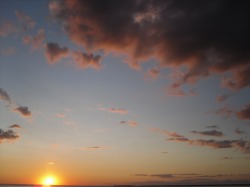Content Questions:
2) The process that determines that life on Earth can only access ten percent of the sun's energy that reaches the planet is called photosynthesis.
3) The passage states that when the ecosystem is damaged, “top carnivores” are the first to go hungry because they live off such a small portion of life’s available energy. It further explains this by going into the two hierarchies of biological diversity, one of which is the energy pyramid. The energy pyramid is defined as a “straightforward consequence of the law of diminishing energy flow... a relatively large amount from the sun’s energy incident on earth goes into the plants at the bottom, tapering to a minute quantity to the big carnivores on top.” (p 256) What does all this mean? Well, essentially what is being said is that plants soak up ten percent of the sun’s energy, this energy is then dispersed respectively throughout the different species in the food chain, starting with those who directly consume the plants. As each creature on the food chain consumes those below it, the percentage of that energy exponentially decreases. By the time “top carnivores” consume their prey, the portion of the sun’s energy being ingested is only a fraction of the initial energy that was used in photosynthesis.
4) The energy and biomass pyramids that Wilson describes are essentially congruent to one another (for species above sea level). This suggests that the amount of solar energy absorbed/consumed by a species is directly related to it's respective weight within the biosphere. This concept can at first be confusing because of course a mountain lion or peregrine falcon is in fact much heavier than a fern or even mold, but biomass is measured in regards to a species as a whole. Though this is going on to answer question five, I think it is important to note that Wilson’s biomass pyramid is actually inverted below sea level. Why? Because the photosynthetic organisms below sea level are not plants, they are phytoplankton- microscopic single-celled algae that is continually displaced by water currents. Zooplankton then consume this algae and are likewise consumed by larger fish and marine animals (“top carnivores”) The larger animals ultimately amount to more bulk than these single-celled organisms (which, interestingly enough, actually generate more protoplasm tan plans on land and affix more solar energy, and grow, divide, and die at a much faster rate).
2) The process that determines that life on Earth can only access ten percent of the sun's energy that reaches the planet is called photosynthesis.
3) The passage states that when the ecosystem is damaged, “top carnivores” are the first to go hungry because they live off such a small portion of life’s available energy. It further explains this by going into the two hierarchies of biological diversity, one of which is the energy pyramid. The energy pyramid is defined as a “straightforward consequence of the law of diminishing energy flow... a relatively large amount from the sun’s energy incident on earth goes into the plants at the bottom, tapering to a minute quantity to the big carnivores on top.” (p 256) What does all this mean? Well, essentially what is being said is that plants soak up ten percent of the sun’s energy, this energy is then dispersed respectively throughout the different species in the food chain, starting with those who directly consume the plants. As each creature on the food chain consumes those below it, the percentage of that energy exponentially decreases. By the time “top carnivores” consume their prey, the portion of the sun’s energy being ingested is only a fraction of the initial energy that was used in photosynthesis.
4) The energy and biomass pyramids that Wilson describes are essentially congruent to one another (for species above sea level). This suggests that the amount of solar energy absorbed/consumed by a species is directly related to it's respective weight within the biosphere. This concept can at first be confusing because of course a mountain lion or peregrine falcon is in fact much heavier than a fern or even mold, but biomass is measured in regards to a species as a whole. Though this is going on to answer question five, I think it is important to note that Wilson’s biomass pyramid is actually inverted below sea level. Why? Because the photosynthetic organisms below sea level are not plants, they are phytoplankton- microscopic single-celled algae that is continually displaced by water currents. Zooplankton then consume this algae and are likewise consumed by larger fish and marine animals (“top carnivores”) The larger animals ultimately amount to more bulk than these single-celled organisms (which, interestingly enough, actually generate more protoplasm tan plans on land and affix more solar energy, and grow, divide, and die at a much faster rate).

 RSS Feed
RSS Feed